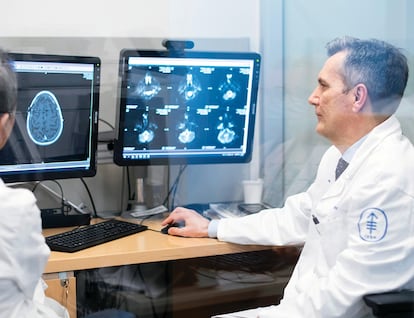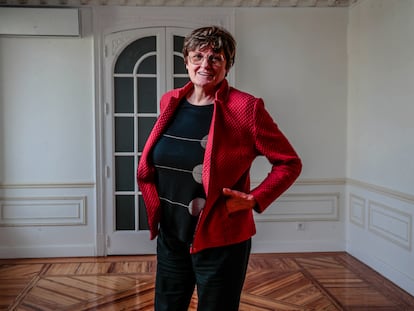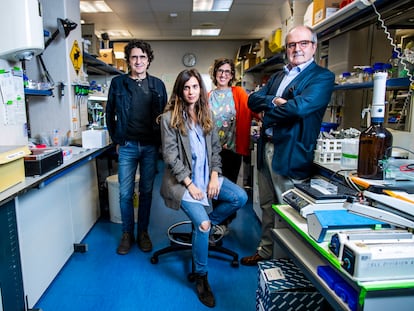Vorasinedib, the new drug giving hope to people with brain tumors
A targeted therapy has more than doubled progression-free survival of patients with gliomas — a disease that killed Spanish golf player Severiano Ballesteros


In 2017, after suffering an epileptic seizure, Alberto (not his real name) received terrible news. That year, at the Jiménez Díaz Hospital in Madrid, he was diagnosed with a strange brain tumor that his doctors did not know how to treat. Undecided, after surgery “they decided not to give me chemotherapy or radiotherapy and see what happened,” recalls Alberto. “Afterward,” he says, “I started having more and more frequent seizures, and they decided to operate on me again.” That operation was performed by another surgeon, who offered to remove the entire tumor. After the operation, Alberto lost mobility on the right side of his body and had to begin a difficult rehabilitation.
“I remember feeling lost at seeing that the doctors didn’t know what path to take. That made me look for another surgeon on my own, and I ended up finding Dr. Sepúlveda,” he says. Juan Manuel Sepúlveda, coordinator of the Neuro-oncology Unit at the 12 de Octubre University Hospital Universitario in Madrid, was surprised to hear that Alberto had not received radiotherapy or chemotherapy. But he told him that, on this occasion, luck had been on his side. Sepúlveda was at the time recruiting patients for the Indigo trial, designed to test a new drug in patients who had received no treatment other than surgery.
Tumors like Alberto’s are known as low-grade gliomas, and it was a glioma of this type that killed the well-known Spanish golfer Severiano Ballesteros. These tumors are characterized by having a mutation in the IDH 1 and 2 genes. This genetic alteration — found thanks to projects to sequence the genomes of dozens of types of cancer, launched in 2008 — changes the activity of two enzymes that are essential to how they function: the enzymes continue to work, but begin to generate a toxic metabolite that damages DNA. Over time, the damage builds up and mutations that fuel cancer growth multiply.
Surgery and deterioration
For decades, people with this condition have undergone surgery to remove the tumor, and then receive chemotherapy and radiation therapy to keep it under control. These tumors are not cured with surgery and usually come back, although their return can be delayed for up to five years. With chemotherapy and radiotherapy, it was possible to prolong a patient’s life between 10 and 20 years, under good conditions. Later, the damage from radiotherapy begins to manifest itself and the patient begins to suffer from memory problems, decreased intellectual performance and difficulty walking quickly. Normally, within 12 or 14 years, patients cannot lead a normal and independent life.
The discovery of IDH mutations allowed the development of drugs aimed at inhibiting the action of this damaged enzyme that poisons the brain. The drug vorasidenib, — which has a special ability to reach the brain — was first used in people with advanced disease, as is almost always the case with experimental drugs. Sepúlveda explains that the drug was giving to patients with “diffuse gliomas that had already been treated with chemotherapy and radiotherapy, in some cases on several occasions.” “But only 30 to 40% of the patients responded,” he recalls.
The figures led researchers to think that the drug was useless, but later they considered that perhaps they had used it too late, when the modification in the expression of the genes and the evolution of the tumor clones had gotten out of control, meaning that inhibiting the enzyme was useless. “So we decided to start at the beginning,” says Sepúlveda. “We did a study for patients with grade 2 glioma who had undergone surgery, but had not received chemo or radiotherapy.” The results of that work have just been presented at the annual meeting of the American Society for Clinical Oncology (ASCO), in Chicago, and were published Sunday in the New England Journal of Medicine.
The Indigo study showed that the drug — developed by the pharmaceutical company Servier — more than doubled progression-free survival. While in the placebo group, the disease did not progress for 11.1 months, in the vorasidenib group, the figure was 27.7 months. Two and a half years after the start of the study — which included 331 patients from around the world — the disease had progressed in 28% of the participants in the vorasidenib group, compared to 54% of those who received placebo. “This represents the first new treatment option for low-grade diffuse glioma in more than 20 years — and the first molecularly targeted therapy specifically developed for this disease,” the study’s lead author, Ingo Mellinghoff, from the Memorial Sloan Kettering Cancer Center in New York, said in a press release.
“For now, we can say that we have wound back by 27 months the moment when these people have to receive more aggressive treatments with more long-term side effects,” says Sepúlveda, who believes that there will be a group of very long-term survivors, as patients respond well to the drug. “There is a patient who started taking it three years ago. The tumor has shrunk and can no longer seen, and we don’t know how long it may stay that way,” he says.
“This opens the door to personalized medicine for these patients,” says Cristóbal Belda, the director of the Carlos III Health Institute in Spain, who formerly treated Ballesteros for his brain tumor. “This disease is rare, it is a very rare type of tumor, and the results give us hope for a disease in which there was little research,” he adds. “It’s an exceptional advance.”
Six years after his diagnosis and after very challenging periods, in which he needed a large amount of epilepsy medication, and could not even go outside or to rehabilitation, Alberto is now hopeful about the future. “Now we are reducing the medication and I continue to notice improvements because I had lost a lot of physical ability. I couldn’t even get in front of the computer, because I would have an epileptic fit,” explains Alberto, who previously worked as a computer engineer. “Now I can leave the house and go for a walk, which may seem like nothing to you, but to me, it’s incredible, and I am back in intensive rehabilitation. I’m very happy.”
Sign up for our weekly newsletter to get more English-language news coverage from EL PAÍS USA Edition
Tu suscripción se está usando en otro dispositivo
¿Quieres añadir otro usuario a tu suscripción?
Si continúas leyendo en este dispositivo, no se podrá leer en el otro.
FlechaTu suscripción se está usando en otro dispositivo y solo puedes acceder a EL PAÍS desde un dispositivo a la vez.
Si quieres compartir tu cuenta, cambia tu suscripción a la modalidad Premium, así podrás añadir otro usuario. Cada uno accederá con su propia cuenta de email, lo que os permitirá personalizar vuestra experiencia en EL PAÍS.
¿Tienes una suscripción de empresa? Accede aquí para contratar más cuentas.
En el caso de no saber quién está usando tu cuenta, te recomendamos cambiar tu contraseña aquí.
Si decides continuar compartiendo tu cuenta, este mensaje se mostrará en tu dispositivo y en el de la otra persona que está usando tu cuenta de forma indefinida, afectando a tu experiencia de lectura. Puedes consultar aquí los términos y condiciones de la suscripción digital.
More information
Archived In
Últimas noticias
Most viewed
- Oona Chaplin: ‘I told James Cameron that I was living in a treehouse and starting a permaculture project with a friend’
- Reinhard Genzel, Nobel laureate in physics: ‘One-minute videos will never give you the truth’
- Sinaloa Cartel war is taking its toll on Los Chapitos
- Why the price of coffee has skyrocketed: from Brazilian plantations to specialty coffee houses
- Silver prices are going crazy: This is what’s fueling the rally










































